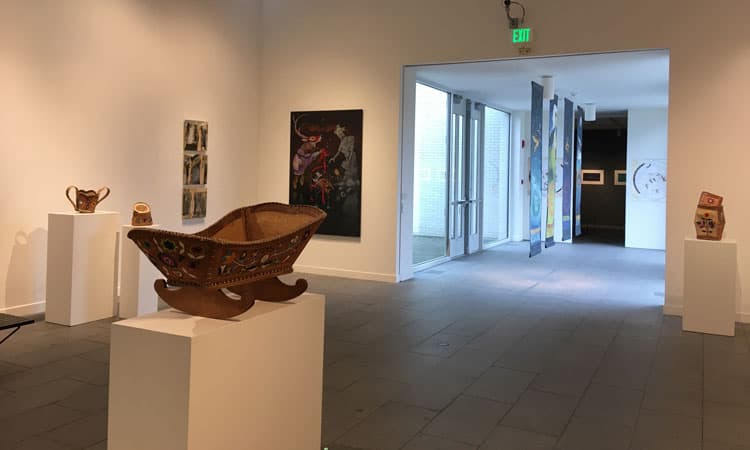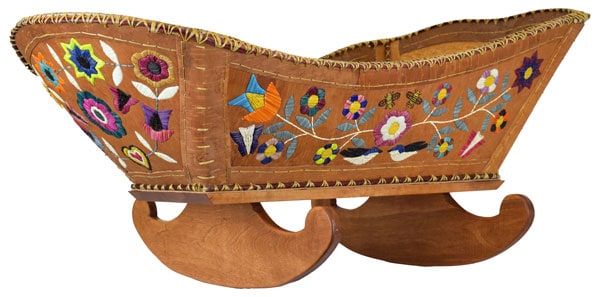In preparation for an exhibition of the work of Native American artists this fall at Saint John’s University, the first of eight visual arts events this academic year at SJU and the College of Saint Benedict, Travis Zimmerman ’94 met with gallery manager Becky Pflueger to view potential pieces.
They sat at the Local Blend, a coffee shop in St. Joseph, with a laptop last spring and cued a virtual tour of paintings by Steve Premo, an artist and former graphic designer for the Mille Lacs Band Corporate Commission. The acrylics were all vibrant and, in a tradition as unique as Premo, thought-provoking.
Perhaps none more than “Cultural Crucifixion.” It depicts an Indian on a cross, being stabbed by a monk with a spear. Small in the left background you can find a Native dressed in a suit and tie, adjusting a noose around his neck prevalent to hanging himself. Similarly, on the other side of the image, you can find Jesus fleeing the scene.
“It’s very powerful,” said Zimmerman, who is guest curator for a show that will feature Premo’s crucifixion painting among contributions from four other premier Native Minnesota artists.
The exhibition is titled “Indigenous Survivance.” Survivance is a theme in the work of Gerald Vizenor, a writer and member of the Minnesota Chippewa Tribe, White Earth Reservation.
“He defined survivance for Native people as a form of resistance,” said Zimmerman, himself a descendant of the Crane Clan of the Grand Portage Band of Lake Superior Chippewa. “He basically said that just the fact we’re still here, as Indians and Native Americans, whether we’re writing books or producing art or making movies, those are all in themselves forms of survivance. We got to this point by survival skills and also resistance. There’s a fine line we walked in trying to address some of these issues directly, and that becomes very powerful.”
The other artists featured include Pat Kruse, Annette S. Lee, Jonathan Thunder and Laura Youngbird. Kruse, a birchbark and quill artist who harvests raw materials from birch trees and porcupine quills to use in his displays, is a descendant of the Mille Lacs Band of Ojibwe and a member of the Red Cliffe Band of Lake Superior Chippewa. Lee, a mixed-race Native American with Lakota, Chinese and Irish ancestry, is a professor of astronomy and longtime former resident of St. Cloud who uses painting, digital storytelling and motion media to explore Indigenous star and earth knowledge. Thunder, a painter and digital artist, is a member of the Red Lake Band of Ojibwe. And Youngbird, a member of the Grand Portage Band, is a mixed media artist who combines drawing and painting.
Show coincides with awakening at CSB and SJU
Zimmerman, Pflueger and Tanya Gertz, executive director of fine arts, agreed the exhibition would be most topical if the works addressed resistance and survival. In that way, the show also will dovetail with developments on campus in recent years. Saint Benedict’s Monastery and Saint John’s Abbey, as well as faculty, staff and students from CSB, SJU and Saint John’s Preparatory School, have in the past several years become involved in the response to and reckoning with a history where Native Americans were sent to industrial schools and pressured to discard their own culture and convert to Christianity. The Sisters of the Order of Saint Benedict were involved with four such schools, among hundreds across the U.S. and Canada, including one on land that belongs to the monastery and another on land that belongs to the abbey. Though any connection to those boarding schools has been severed for more than 50 years, only recently has the impact become more widely acknowledged. In 2021, Saint Benedict’s Monastery issued a formal apology for its role in that history and, for more than a year now, classes and presentations at CSB and SJU have been preceded by a land acknowledgement referring to the boarding school history.
Not coincidentally, Zimmerman has been part of a 12-member task force coalescing from the monastery, abbey, schools and Native tribes to recognize that history, channel it and support Indigenous students going forward.
“Part of the work we’ve been doing is acknowledging institutions and their past and the role they’ve played in colonization, but also: How do we repair the harm?” he said. “I think that comes out of the Benedictine tradition ingrained at Saint John’s and Saint Ben’s. Let’s not only acknowledge what happened but be accountable and help our fellow man … This work doesn’t stop. Reconciliation is a process. There isn’t an end game.”
Zimmerman, a U.S. Army and National Guard veteran, works for the Minnesota Historical Society (MHS) as site manager for the Mille Lacs Indian Museum and Trading Post. It was there last winter that another task force member, Ted Gordon, an adjunct professor at CSB and SJU, specializing in Native American history and culture, introduced Zimmerman to Pflueger and Gertz.
They talked about important historical works of famous Indian artists like George Morrison and Patrick DesJarlait, but ultimately decided it would be better to go with contemporary works. Zimmerman recruited the contributors, seeking representation from different tribes – Ojibwe and Dakota/Lakota – as well as an array of men and women who work with different media.
“The more we talked about it, the more we decided to have the artwork revolve around issues of social justice,” Zimmerman said. “This art is affected by the boarding schools and assimilation … We’re really happy with who we got.”
Contributors have long list of credentials
Kruse was named Native Artist-In-Residence at the MHS in 2015, and twice has been selected as a fellow for the Native Arts and Cultures Foundation. His art is housed in the Smithsonian and the Science Museum of Minnesota.
“Pat’s work stems from his traditional knowledge,” Zimmerman said. “In preparing for the show, one of his pieces fell off the wall. It’s heavy and he didn’t have a strong enough cable. Becky called and said everything was all right. Nothing got broke. But she wanted to be sure he was OK with having a stronger cable as an adjustment to his art. I called him and it sounded like I was on speakerphone. He was out wild ricing. You talk about survivance, he does it in so many ways. He harvests all the birch bark he uses. Sometimes people look at the price of art and they don’t understand how something can be so expensive. They don’t realize how much work goes into something that’s handmade. You don’t get porcupine quills from Walmart … He can probably tell you where each piece of bark came from and whether the tree was dead or alive, young or old, harvested or regrowth.”

Indigenous Survivance will be on display through Oct. 29 at the Saint John’s Art Center. It features the work of five premier Native American artists with Minnesota ties. Among the items are a bassinette created by Pat Kruse, a descendant of the Mille Lacs Band of Ojibwe and a member of the Red Cliffe Band of Lake Superior Chippewa. Other pieces on display include paintings, banners and multimedia displays from Annette S. Lee, Jonathan Thunder, Laura Youngbird and Steve Premo.
Lee has a master of fine arts from Yale, a master of science in astrophysics from Washington University in St. Louis, Missouri, and a Ph.D. in physics and astronomy from University of the Western Cape in Cape Town, South Africa. She has co-curated an exhibit for Canada’s Museum of Science and Technology-Ingenium and teaches astronomy at three different universities.
“She’s made these incredible star maps that are both Ojibwe and Dakota/Lakota,” Zimmerman said. “Basically, she’s saying ‘Hey, we had constellations, too.’ They aren’t unique to the Greeks. She superimposed the different constellations on top of each other so you can see how they relate and how there’s crossover. They were all used in the same way, to forecast the coming seasons and, for Natives, when to migrate from summer camp to fall camp.”
Thunder, who lives in Duluth, attended the Institute of American Indian Arts in Santa Fe, New Mexico, as well as the Art Institute International in Minneapolis, which closed in 2019. He is the recipient of a 2020-21 Pollock-Krasner Foundation award for risk-taking in painting. He has also won awards for short films. This year, he was awarded a McKnight Visual Artist Fellowship.
“I appreciate Jonathan’s stuff so much,” Zimmerman said. “It’s mind-blowing. You can get lost and wonder ‘Wow. What was he thinking when he did this?’ … There is real character to his paintings and he has a lot of pop culture influence – not just for the colors and design but the story he’s trying to tell. It’s subtle, though. Sometimes you need him to tell you what you’re looking at.”
Youngbird, who lives in Breckenridge, Minnesota, has a master of arts in drawing and printmaking from Minnesota State-Moorhead and served a Jerome Fellowship with Master Potter Richard Bresnahan in 2003 at SJU.
“Laura’s work is very profound,” Zimmerman said. “She has one painting called ‘Assimilation Dress’ that makes you think. Her pieces are very conscious.”
Sept. 8 reception will include drum circle, Indigenous food
Zimmerman, a history major, looks forward to reconnecting with the SJU and CSB campuses. He and all the artists will be present for a reception from 5-7 p.m., Sept. 8, at the Saint John’s Art Center. It will begin with a welcoming song from a Native drum circle, blessings from an elder and a priest, a chance for attendees to partake Indigenous food, and music from a flutist.
“I never knew the history of the boarding schools when I was there,” Zimmerman said. “They have an Indigenous Students Association now, which I think is cool. I knew a few Native students when I was there, but not many. Most dropped out when they got homesick, because there was no support network in place for them. I think what’s happening now is good work. It’s a great education at Saint Ben’s and Saint John’s. I really appreciated it and I want other Native people to have that experience, too.
“It’s always empowering when you see yourself. Perhaps there will be some first-year students coming through that will see a piece that will resonate. This experience sure got me out of my comfort zone. Historical trauma can be passed from generation to generation and there are some things that can trigger that in this show. But these are good things to talk about.”
Indigenous Survivance is made possible by a Central Minnesota Arts Board grant, thanks to a legislative appropriation from the Arts and Cultural Heritage Fund and the voters of Minnesota. The Indigenous Student Association at CSB and SJU also helped fund the exhibit.

Bassinette created by Pat Kruse.
Visual Arts Series at CSB+SJU
CSB gallery hours:
- 10 a.m. to 9 p.m., Monday through Saturday
SJU gallery hours:
- 2-6 p.m. on Tuesday, Wednesday, Friday and Saturday
- 2-8 p.m. on Thursday
